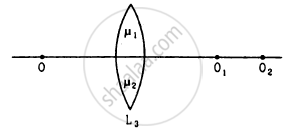Advertisements
Advertisements
Question
(a) At what distance should the lens be held from the figure in order to view the squares distinctly with the maximum possible magnifying power?
(b) What is the magnification in this case?
(c) Is the magnification equal to the magnifying power in this case? Explain.

Solution
(a) The maximum possible magnification is obtained when the image is formed at the near point (d = 25 cm).
Image distance, v = −d = −25 cm
Focal length, f = 10 cm
Object distance = u
According to the lens formula, we have:
`1/"f" = 1/"v" - 1/"u"`
`1/"u" = 1/"v" - 1/"f"`
= `1/(-25) - 1/10`
= `(-2-5)/50`
= `- 7/50`
∴ u = `50/7` = −7.14 cm
Hence, to view the squares distinctly, the lens should be kept 7.14 cm away from them.
(b) Magnification = `|"v"/"u"| = 25/(50/7)` = 3.5
(c) Magnifying power = `"d"/"u" = 25/(50/7)` = 3.5
Since the image is formed at the near point (25 cm), the magnifying power is equal to the magnitude of magnification.
APPEARS IN
RELATED QUESTIONS
What does sign of power (+ve or –ve) indicate?
How unit of power related to focal length of a lens?
A doctor has prescribed a corrective lens of power +1.5 D. Find the focal length of the lens. Is the prescribed lens diverging or converging?
Give the usual name for the following:
A point inside a lens through which the light passes undeviated.
The lens A has a focal length of 25 cm whereas another lens B has a focal length of 60 cm. Giving reason state, which lens has more power: A or B.
Which of the two has a greater power: a lens of short focal length or a lens of large focal length?
How is the power of a lens related to its focal length?
A converging lens has focal length of 50 mm. What is the power of the lens?
A lens has a focal length of, −10 cm. What is the power of the lens and what is its nature?
What is the unit of power of a lens? Define the unit of power of a lens.
How is the power of a lens related to its focal length?
How is the sign (+ or -) of power of a lens related to its divergent or convergent action?
On reducing the focal length of a lens, its power ______.
Consider three converging lenses L1, L2 and L3 having identical geometrical construction. The index of refraction of L1 and L2 are \[\mu_1 \text{ and } \mu_2\] respectively. The upper half of the lens L3 has a refractive index \[\mu_1\] and the lower half has \[\mu_2\] following figure . A point object O is imaged at O1 by the lens L1 and at O2 by the lens L2placed in same position. If L3 is placed at the same place,
(a) there will be an image at O1
(b) there will be an image at O2.
(c) the only image will form somewhere between O1 and O2
(d) the only image will form away from O2.
How is accommodation produced?
A lens forms an upright and diminished image of an object, irrespective of its position. What kind of lens is this? Draw an outline ray diagram to show the formation of the image. State the position and one more characteristic of the image.
Find the power of a convex lens of focal length of + 25 cm.
If focal length of a convex lens is 20 cm at what is the power of the lens?
